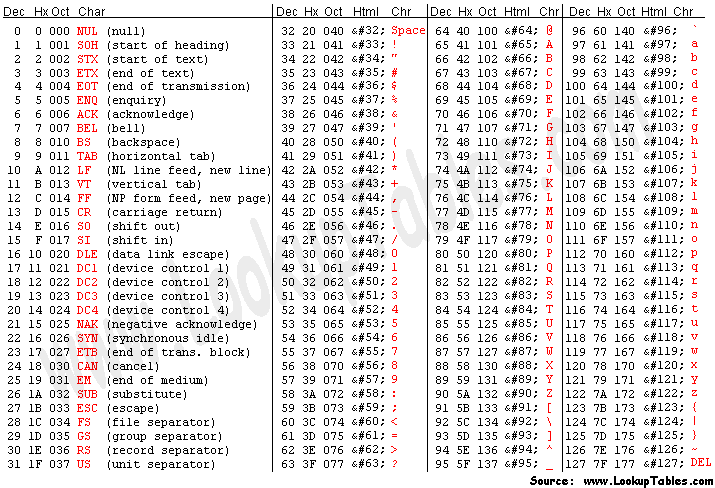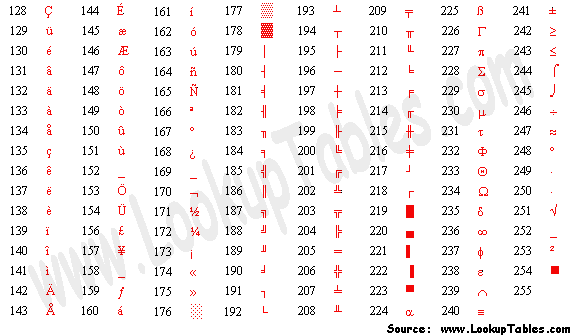Difference between revisions of "ASCII"
m (→Text ASCII Table) |
m (→Text ASCII Table) |
||
| Line 105: | Line 105: | ||
| 33||21||!||||97||61||a | | 33||21||!||||97||61||a | ||
|- | |- | ||
| − | | 34||22|| | + | | 34||22||"||||98||62||b |
|- | |- | ||
| 35||23||#||||99||63||c | | 35||23||#||||99||63||c | ||
Revision as of 06:03, 14 April 2008
ASCII - (pronounced /ˈæski/) The American Standard Code for Information Interchange is a standard seven-bit code that was proposed by ANSI in 1963, and finalized in 1968, and maybe a guy named Robert W. Bemer was involved in the process. ASCII specifies a correspondence between digital bit patterns and character symbols. The purpose is to create a standard for computers, and other data processing equipment. ASCII developed from telegraphic codes and its first commercial use was as a seven-bit teleprinter code promoted by Bell data services.
The standard ASCII character set uses 7-bit code and consists of 128 decimal numbers ranging from zero through 127 assigned to letters, numbers, punctuation marks, and the most common special characters. The Extended ASCII Character Set also consists of 128 decimal numbers and ranges from 128 through 255 representing additional special, mathematical, graphic, and foreign characters. On common 8-bit systems, an 8th parity bit compliments the patterns of seven binary digits (a range of 0 to 127 decimal) which represent each ASCII character.
The later added extended ASCII characters were added to the original ASCII character set as the result of the computer industry specifically. MS-DOS uses a superset of ASCII called extended ASCII or high ASCII. The extended character set uses 8-bit encoding rather than 7-bit.
- control characters: ASCII reserves the first 32 codes (numbers 0–31 decimal) for control characters such as printer control and device control.
- printable characters: a space, letters, digits, punctuation marks, and printable symbols.
- extended characters: 8-bit later addition to the original ASCII characters include non-English characters, graphics symbols, and mathematical symbols.
ASCII Table Charts
The website LookupTables has two of the best ASCII table charts available.
Lower ASCII Table
source: http://www.lookuptables.com/
Upper ASCII Table
source: http://www.lookuptables.com/
Text ASCII Table
This chart is a text table rather than a graphic illustration.
| ASCII | HEX | DESC | ASCII | HEX | DESC | |
| 0 | 0 | NUL | 64 | 40 | @ | |
| 1 | 1 | SOH | 65 | 41 | A | |
| 2 | 2 | STX | 66 | 42 | B | |
| 3 | 3 | ETX | 67 | 43 | C | |
| 4 | 4 | EOT | 68 | 44 | D | |
| 5 | 5 | ENQ | 69 | 45 | E | |
| 6 | 6 | ACK | 70 | 46 | F | |
| 7 | 7 | BEL | 71 | 47 | G | |
| 8 | 8 | BS | 72 | 48 | H | |
| 9 | 9 | TAB | 73 | 49 | I | |
| 10 | A | LF | 74 | 4A | J | |
| 11 | B | VT | 75 | 4B | K | |
| 12 | C | FF | 76 | 4C | L | |
| 13 | D | CR | 77 | 4D | M | |
| 14 | E | SO | 78 | 4E | N | |
| 15 | F | SI | 79 | 4F | O | |
| 16 | 10 | DLE | 80 | 50 | P | |
| 17 | 11 | DC1 | 81 | 51 | Q | |
| 18 | 12 | DC2 | 82 | 52 | R | |
| 19 | 13 | DC3 | 83 | 53 | S | |
| 20 | 14 | DC4 | 84 | 54 | T | |
| 21 | 15 | NAK | 85 | 55 | U | |
| 22 | 16 | SYN | 86 | 56 | V | |
| 23 | 17 | ETB | 87 | 57 | W | |
| 24 | 18 | CAN | 88 | 58 | X | |
| 25 | 19 | EM | 89 | 59 | Y | |
| 26 | 1A | SUB | 90 | 5A | Z | |
| 27 | 1B | ESC | 91 | 5B | [ | |
| 28 | 1C | FS | 92 | 5C | \\ | |
| 29 | 1D | GS | 93 | 5D | ] | |
| 30 | 1E | RS | 94 | 5E | ^ | |
| 31 | 1F | US | 95 | 5F | _ | |
| 32 | 20 | (space) | 96 | 60 | ` | |
| 33 | 21 | ! | 97 | 61 | a | |
| 34 | 22 | " | 98 | 62 | b | |
| 35 | 23 | # | 99 | 63 | c | |
| 36 | 24 | $ | 100 | 64 | d | |
| 37 | 25 | % | 101 | 65 | e | |
| 38 | 26 | & | 102 | 66 | f | |
| 39 | 27 | \' | 103 | 67 | g | |
| 40 | 28 | ( | 104 | 68 | h | |
| 41 | 29 | ) | 105 | 69 | i | |
| 42 | 2A | * | 106 | 6A | j | |
| 43 | 2B | + | 107 | 6B | k | |
| 44 | 2C | , | 108 | 6C | l | |
| 45 | 2D | - | 109 | 6D | m | |
| 46 | 2E | . | 110 | 6E | n | |
| 47 | 2F | / | 111 | 6F | o | |
| 48 | 30 | 0 | 112 | 70 | p | |
| 49 | 31 | 1 | 113 | 71 | q | |
| 50 | 32 | 2 | 114 | 72 | r | |
| 51 | 33 | 3 | 115 | 73 | s | |
| 52 | 34 | 4 | 116 | 74 | t | |
| 53 | 35 | 5 | 117 | 75 | u | |
| 54 | 36 | 6 | 118 | 76 | v | |
| 55 | 37 | 7 | 119 | 77 | w | |
| 56 | 38 | 8 | 120 | 78 | x | |
| 57 | 39 | 9 | 121 | 79 | y | |
| 58 | 3A | : | 122 | 7A | z | |
| 59 | 3B | ; | 123 | 7B | { | |
| 60 | 3C | < | 124 | 7C | ||
| 61 | 3D | = | 125 | 7D | } | |
| 62 | 3E | > | 126 | 7E | ~ | |
| 63 | 3F | ? | 127 | 7F | | |

